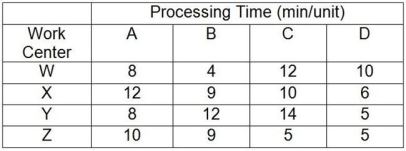Table 5.2
A company makes four products that have the following characteristics: Product A sells for $75 but needs $20 of materials and $20 of labor to produce; Product B sells for $90 but needs $45 of materials and $20 of labor to produce; Product C sells for $110 but needs $50 of materials and $30 of labor to produce; Product D sells for $135 but needs $75 of materials and $40 of labor to produce. The processing requirements for each product on each of the four machines are shown in the table.

Work centers W, X, Y, and Z are available for 40 hours per week and have no setup time when switching between products. Market demand is 50 As, 60 Bs, 70 Cs, and 80 Ds per week. In the questions that follow, the traditional method refers to maximizing the contribution margin per unit for each product, and the bottleneck method refers to maximizing the contribution margin per minute at the bottleneck for each product.
-Use the information in Table 5.2. Using the traditional method, which product should be scheduled first?
Definitions:
Q15: _ refers to mistake-proofing methods aimed at
Q39: A manufacturer embarking on a Six Sigma
Q55: The dispersion of forecast errors is measured
Q94: Larry's Wickets, Inc. is producing two types
Q101: When should complete inspection be used?<br>A) when
Q116: Using salesforce estimates for forecasting has the
Q123: The five categories of activities (operation, transportation,
Q145: The lean system concept will not work
Q166: Cross-functional coordination is at particular risk where:<br>A)
Q179: The advantage of variable measurements is that